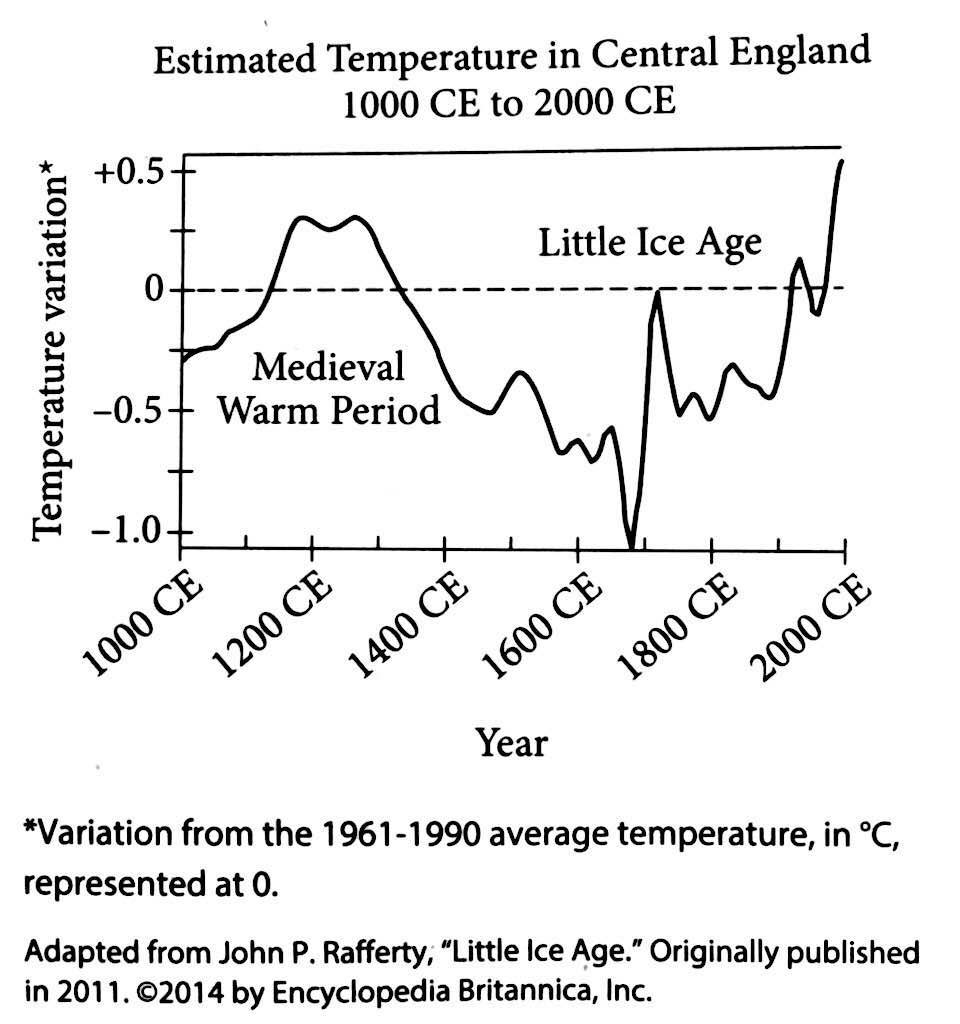Questions 42-52 are based on the following
passage.
This passage is adapted from Carolyn Gramling, “Source of Mysterious Medieval Eruption Identified.”© 2013 by American Association for the Advancement of Science.
About 750 years ago,a powerful volcano erupted
somewhere on Earth,kicking off a centuries-long
cold snap known as the Little Ice Age.Identifying the
volcano responsible has been tricky.
5 That a powerful volcano erupted somewhere in
the world,sometime in the Middle Ages,is written in
polar ice cores in the form of layers of sulfate
deposits and tiny shards of volcanic glass. These
cores suggest that the amount of sulfur the mystery
10 volcano sent into the stratosphere put it firmly
among the ranks of the strongest climate-perturbing
eruptions of the current geological epoch,the
Holocene, a period that stretches from 10,000 years
ago to the present. A haze of stratospheric sulfur
15 cools the climate by reflecting solar energy back into
space.
In 2012, a team of scientists led by geochemist
Gifford Miller strengthened the link between the
mystery eruption and the onset of the Little Ice Age
20 by using radiocarbon dating of dead plant material
from beneath the ice caps on Baffin Island and
Iceland, as well as ice and sediment core data,to
determine that the cold summers and ice growth
began abruptly between 1275 and 1300C.E.(and
25 became intensified between 1430 and 1455C.E.).
Such a sudden onset pointed to a huge volcanic
eruption injecting sulfur into the stratosphere and
starting the cooling. Subsequent,u nusually large and
frequent eruptions of other volcanoes, as well as
30 sea-ice/ocean feedbacks persisting long after the
aerosols have been removed from the atmosphere,
may have prolonged the cooling through the 1700s.
Volcanologist Franck Lavigne and colleagues now
think they’ve identified the volcano in question:
35 Indonesia’s Samalas.One line of evidence,they note,
is historical records. According to Babad Lombok,
records of the island written on palm leaves in Old
Javanese, Samalas erupted catastrophically before the
end of the 13th century, devastating surrounding
40 villages—including Lombok’s capital at the time,
Pamatan—with ash and fast-moving sweeps of hot
rock and gas called pyroclastic flows.
The researchers then began to reconstruct the
formation of the large,800-meter-deep caldera[a
45 basin-shaped volcanic crater] that now sits atop the
volcano.They examined 130 outcrops on the flanks
of the volcano, exposing sequences of pumice—ash
hardened into rock—and other pyroclastic material.
The volume of ash deposited, and the estimated
50 height of the eruption plume (43 kilometers above
sea level) put the eruption’s magnitude at a
minimum of 7 on the volcanic explosivity index
(which has a scale of 1 to 8)—making it one of the
largest known in the Holocene.
55 The team also performed radiocarbon analyses on
carbonized tree trunks and branches buried within
the pyroclastic deposits to confirm the date of the
eruption; it could not,they concluded, have
happened before 1257C.E.,and certainly happened
60 in the 13th century.
It’s not a total surprise that an Indonesian volcano
might be the source of the eruption,Miller says.“An
equatorial eruption is more consistent with the
apparent climate impacts.”And, he adds, with sulfate
65 appearing in both polar ice caps—Arctic and
Antarctic—there is“a strong consensus”that this
also supports an equatorial source.
Another possible candidate—both in terms of
timing and geographical location—is Ecuador’s
70 Quilotoa,estimated to have last erupted between
1147 and 1320C.E.But when Lavigne’s team
examined shards of volcanic glass from this volcano,
they found that they didn’t match the chemical
composition of the glass found in polar ice cores,
75 whereas the Samalas glass is a much closer match.
That,they suggest,further strengthens the case that
Samalas was responsible for themedieval“year
without summer”in 1258 C.E.